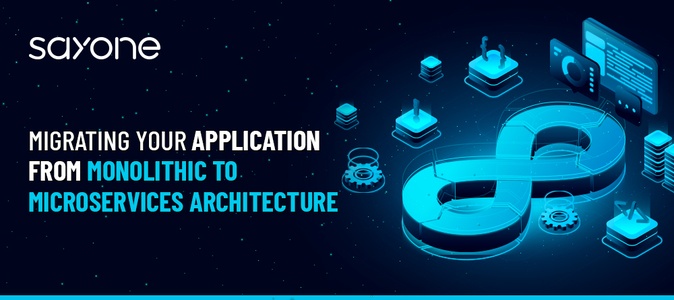Developing Microapps using Microservices Architecture – An overview

Share This Article
Migrating Your Application from Monolithic to Microservices Architecture
Table of Contents
Subscribe to Our Blog
We're committed to your privacy. SayOne uses the information you provide to us to contact you about our relevant content, products, and services. check out our privacy policy.
Microapps are a much-talked-about topic right now. However, many of us do not know what a micro-app is or how its use can benefit us. Is the usage of microapps going to be beneficial or is it just another fad? We attempt to answer these questions in a simple fashion.
Microservices architecture is many a time confused with microapps. Microservices are smaller back-end services that are stable and designed to perform a single function. They are usually organized around business applications, where each service performs a specific business function and is easily maintainable and testable.
Some of the questions about microapps that we tend to ask ourselves are:
- What are microapps?
- How do microapps support business functions?
- How can you create microapps using a platform built as a microservices architecture platform?
What are Microapps
A microapp is similar to any other app that resides on your mobile phone. However, it is designed to perform a single task and that too very well. Microapps are built to exercise this principle and use them for creating exclusive mobile experiences.
Developers are creating microapps by isolating modules inside dedicated codebases. This has helped them to avoid lengthy build times and continue to work on dedicated and feature-specific apps that provide a faster feedback cycle.
Read our blog “How to find the best microservices development company”.
You should also understand that microapps are not very new. We all have been using microapps without realizing it. Google uses microapps in their search results. In cases where you want to look at the latest standings of your favorite sports teams, microapps get to work. They are tiny apps that are very focused and procure all the information for you. You do not have to wade through unnecessary information to get to what you want then.
Microapps work to produce extra value for the consumer. The microapps serve to produce exactly what the consumers want, without the need for any extra overheads. Microapps can also be compared to similar smaller programs in a web portal. Portlets in web portals also perform similar kinds of focused functions for users of the portal. Therefore, microapps can be thought of as similar apps working to provide uses to users of mobile apps. Given below is an output rendered by working microapps.
Design of Microapps
Microservices design is one in which segregated areas of a backend are deployed individually. In a similar manner, mobile developers take out the different core parts of an application such as single features, low-level capabilities, and shared business logic and move them to libraries containing standalone modules. These modules are independent of one another and also from the main app codebase so that teams can work on them autonomously.
What sets this architecture model apart is the use of module-specific applications—microapps—which are used as tools for quick development and testing. Teams can build more than one internal-facing microapps tailored to specific needs, including the modules that are necessary for the specific feature they’re working on.
Read our eBook for FREE “Scaling microservices in a cloud-native environment”.
As an example, a team that is working on the ‘checkout’ component of an e-commerce app, could build a microapp for enumerating combinations of payment methods, shipping addresses, and cart contents. This would allow them to test the flow of checkout much faster than if they had to place these combinations inside the main application.
Dedicated microapps for specific features are a great advantage to improve iteration speed. A microapp can be created much faster than the whole user-facing application because there is much less code to compile. Also, microapps are built only for internal use and do not require any polished UX. It can also come can come pre-seeded with the necessary test data, and can escape entire aspects such as onboarding. This reduces friction when verifying the changes, and compounds with a faster build time help to create a more rapid and efficient development cycle.
Do you want to deploy, manage, and scale up your mobile/on-premise/cloud microservices applications? Call us today!
The microapps architecture is a modular design complemented by the use of dedicated microapps for development and testing which serve to increase development speed. Here, the pattern is more abstract than a well-defined framework (like MVC[model–view–controller] or MVVM [model–view–viewmodel]), as the architecture will vary depending on the specific app’s features. Though there is no one-size-fits-all approach, the same pillars are used to support all successful implementations.
Business value of Microapps
If you are an employee in an enterprise, you have to use close to 20 apps to get your job done. Each of these apps may not contribute to focused functionalities either. App fatigue also happens as our mobile devices are loaded with hundreds of apps both at our workplaces and for our jobs to get done. We have to store as well as use these.
From the developer’s perspective, the app developers also bear the brunt of maintaining these apps. There are more requests for new apps and this adds to the number of apps to be maintained. Moreover, each app comes with a host of several small jobs that get the app going such as authentication, notifications, offline access, metadata management, device logging, crash analytics, app submission/approval, app updates, app distribution, branding &theming, authorization/provisioning, performance/health monitoring, etc.
We believe in long-term win-win relationships with our strategic partners. If you want to migrate to microservices, call us today!
If you have microapps for each of these jobs, you could get bored out of the way and concentrate on the practical features that you want to deliver to your clients. However, you will have to create the UI and build the backend business logic.
App User’s Perspective
From the viewpoint of the app user/consumer, they require many features, as they become pickier, such as:
- Ability to use both iOS and Android devices to run apps (cross-platform capability)
- Apps should have the ability to respond quickly and reliably (60 fps native UI speed)
- I should be able to use the device to its fullest capabilities (access to any device API should be available)
- The apps should provide an immersive customer experience to up engagement (AR/VR experience)
- Ability to interact with chatbots (chatbot interfaces)
Therefore, when using microapps, app consumers can have one single app that provides the focused functionality that is required, coupled together with modern and engaging features that today’s consumers so badly want.
Conclusion
Microapps architecture is still in its fledgling state and there are many opportunities for teams to innovate these approaches. There is little doubt that this emerging architecture pattern can invigorate feature development and increase developer velocity.
How SayOne can assist in Microservices Development
At SayOne, we offer independent and stable services that have separate development aspects as well as maintenance advantages. We build microservices especially suited for individuals' businesses in different industry verticals. In the longer term, this would allow your organization/business to enjoy a sizeable increase in both growth and efficiency. We create microservices as APIs with security and the application built in. We provide SDKs that allow for the automatic creation of microservices.
Our comprehensive services in microservices development for start-ups, SMBs, and enterprises start with extensive microservices feasibility analysis to provide our clients with the best services. We use powerful frameworks for our custom-built microservices for different organizations. Our APIs are designed to enable fast iteration, easy deployment, and significantly less time to market. In short, our microservices are dexterous and resilient and deliver the security and reliability required for the different functions.
Share This Article
Subscribe to Our Blog
We're committed to your privacy. SayOne uses the information you provide to us to contact you about our relevant content, products, and services. check out our privacy policy.



